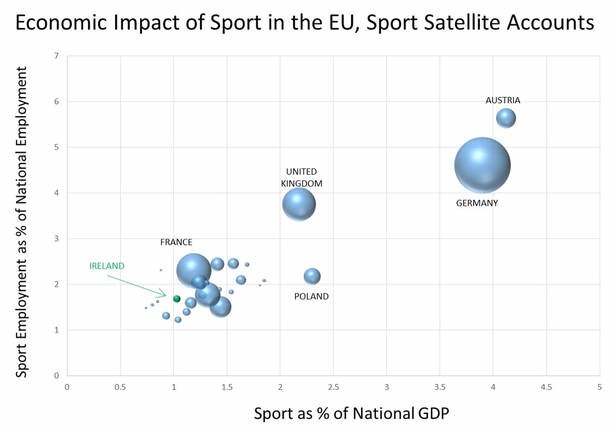Sports has been a constant in the society since ancient era. However, in the recent times, sports have evolved as one of the major industries which contributes to the amelioration of the economy. A European commission report revealed how sports contributed to approx. 21% to the GDP of European Nations. Furthermore, figure 1 reveals how sports contribute imperatively to the GDP as well as employment in Europe. Similarly, in India, IPL (Indian Premiere League) arguably the largest sporting event of India, contributed 182 million dollars to the Indian GDP in 2015 and since then it has been an uphill journey for the contribution of IPL to the Indian economy.
At present the field of sports is dominating the industrial sphere and has emerged as one of the biggest industries. With the augmentation of sports, the connotations attached to the field has evolved from just gaming and entered other arenas such as politics, culture, recreation and business. There has always been staunch support for the sphere of sports, however, with the advent of globalization and other intrinsic developments, the commercialization of the sports industry has increased tenfold. As the data in figure 1 suggests, sports industry has also been a dominant boon for the economy across the years. The focal point of sports has shifted from gaming to profit proliferation. This commercialization of sports attract competition and in turn competition law also plays a significant role in sports. This role of “competition law in sports” has been explored further in another article.

Where there is competition, there is bound to be unfair play and the primary focus of competition law is to restrain these anti-competitive activities. With the amelioration of sports, the sport federations have been garnering concentrated power and allegedly have been misusing their monopolistic for undue advantage in their respective industries. The foremost reason for a situation is the lack of a body to regulate the operations of these sports organizations, this loophole, presents the latter with the laxity to partake in arbitrary acts. The issues related to sports and competition law has been covered further in chapter 3 of this paper. Furthermore, chapter 4 of this paper provides recommendations for some of these problems.
Some of the renowned sport federations such as “Board for Control of Cricket in India (BCCI)”, “Athletics Federation of India (AFI)” and “All India Chess Federation (AICF)” are also not unsusceptible from anti-competitive practices and have been dragged through proceedings under “section 3 and 4 of Competition Act, 2002” which deal with “anti-competitive behaviour” and “misuse of dominant position”. These cases have been further detailed and analysed in another article.
Sports has been omnipresent in the Indian society; however, competition law is relatively a new law field and the interplay between the two have been gradually developing with competition law playing a more active role in the sports sector. The modernity and recent progression of “competition law in sports” is intriguing and this paper presents a brief account of the same.
Reference
- EUROPEAN COMMISSION, DIRECTORATE-GENERAL FOR EDUCATION, YOUTH, SPORT AND CULTURE, STUDY ON THE ECONOMIC IMPACT OF SPORT THROUGH SPORT SATELLITE ACCOUNTS, (2018), https://data.europa.eu/doi/10.2766/156532.
- Manas Tiwary, IPL economy: What the cash rich league adds to India’s GDP, FINANCIAL EXPRESS (Jan. 22, 2018, 3:35 pm), https://www.financialexpress.com/sports/ipl/ipl-economy-what-the-cash-rich-league-adds-to-indias-gdp/1025063/.
- Naman Khanna, An Analysis of the Interrelationship of Competition Law & Sports in India through Emerging Landmark Case Laws, 3(5) INTERNATIONAL JOURNAL OF LAW MANAGEMENT AND HUMANITIES 1375, 1375-1376 (2020).
- Gurang Kanth, Emergence of Sports Law in India, 3(2) INDIA LAW JOURNAL (2009).
- Khanna, supra note 3, at 1376.

Leave a Reply